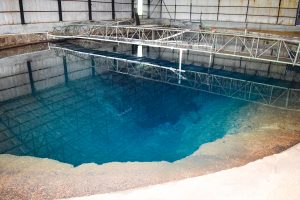
The U.S. Geological Survey estimates that at least one-tenth of all freshwater originates or flows through Alabama. One of the state’s most eye-catching drinking water sources is hiding in Blount County among the foothills of the Southern Appalachian Mountains. Protected beneath a white barnlike structure with a dark green roof, the 60-foot wide and 35-foot deep Blue Spring sits on approximately 88 acres where its water is collected and bottled by Blue Spring Living Water owners Cameron and Elizabeth Cardwell, both former students from The University of Alabama.
“It’s a naturally occurring centuries-old spring that flows about a million gallons per day,” said Elizabeth Cardwell. “It’s 52 degrees year-round, and the water temperature never changes.”
The spring originates deep below in the Bangor Aquifer. Its water takes quite a long time to surface – the current water in the harvesting pool began its trip up from the aquifer 300 years ago. During the time that today’s water was being pushed to the surface, the spring itself was being discovered. The local story is that both Davy Crockett and Andrew Jackson stumbled upon it back in the 1800s.
“It’s pretty amazing for us because if you think about three centuries, there’s no groundwater contamination, insecticides or any kind of industrial pollutants, but it flows through limestone and dolomite,” said Cameron Cardwell.
The water is routinely tested and has a constant pH level of 7.1-7.2. It contains naturally occurring silica, magnesium and calcium.
The spring gets its name from the glowing bluish hue of the pool, and its clarity is striking. A few windows allow enough sunlight into the building where one can see straight to the bottom. A bridge stretching across the middle of the spring offers a clear view of the deepest part when looking down.
There is enough water flowing to fill roughly 6.5 million of Blue Spring Living Water’s 500 milliliter bottles per day, but they can only produce approximately 20,000. The excess flows out into a pasture and down into Blue Spring Creek where not only plants and animals can enjoy it, but also patrons of the Spring Valley Beach water park a few miles downstream.
The land surrounding Blue Spring was owned by the Vanzandt family until 1950 when it was given to Ottis Shedd. In 1999, Shedd decided to bottle and sell the water. Cameron Cardwell learned about the spring in 2017 and took over its bottling and distribution from Shedd.
The bottling process takes place at the Blue Spring Living Water store and plant a few hundred yards from the actual spring. Workers take the empty bottles and place them onto a conveyor. The bottles ride the conveyer into a room where the water, which is filtered twice using a microfilter and ozone filtering, is pumped into them before exiting the room for labeling and packaging.
The bottling line has a unique history of its own. According to the Cardwells, Shedd found an ad in the newspaper for the machinery in Atlanta around the time he started his bottling business. When he went to purchase it, he discovered its owner was Richard Williams, the father of tennis superstars Venus and Serena Williams.
“I think he had been doing a sports drink around that time, and it was one of the fastest water bottling lines in the state,” said Cameron Cardwell. “It was putting out around 2,500 bottles an hour.”
“And still putting out,” added Elizabeth Cardwell.
Blue Spring Living Water uses bottles that are fully recyclable and BPA-free, and the packaging is also biodegradable. The company believes if its water is pure, its methods of bringing it to the public should be, too.
“We knew if we were going to build our brand, we wanted to be as sustainable as possible,” said Elizabeth Cardwell.
The company services 700 households and offices across Alabama with five-gallon jugs, which is also part of their sustainable mission.
“Our distributor picks up those empty jugs, and we sanitize them, refill them, reuse them and get them back out there,” she said.
Blue Spring Living Water currently serves about 500 retail stores and customers in addition to its jug program. It’s expanding across the Southeast, hoping to bring a little bit of Alabama to everyone.
“The number one goal is to make sure that everyone that lives here has access to it and knows about what an incredible resource we have in our state,” said Cameron Cardwell. “Not too many people realize it’s in their backyard.”
“We’re on a mission to educate people and tell them what good water is about and why it’s such an important and foundational pillar of health,” said Elizabeth Cardwell. “A lot has been made about locally sourced food, having that connection to farmers and knowing where your food comes from, and that’s how we want people to connect with water.”
In the same way educating people and forming a bond with water is important to the Cardwells, they are eager to discover more about Blue Spring itself. Affiliated faculty members from the Alabama Water Institute will soon visit the spring to help them explore and learn more about their unique resource.
